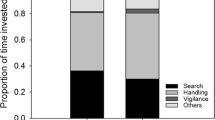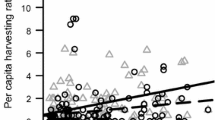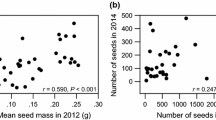Abstract
Scatter-hoarding rodents influence the population dynamics of plants by acting as seed predators and dispersers. Therefore, rodent foraging preferences for certain seed traits (species, size, condition) have been extensively studied. However, to what extent these preferences are fixed or they track the temporal changes on seed characteristics due to phenological differences has been seldom explored. We studied the temporal variability in seed preferences by wood mouse (Apodemus sylvaticus), according to phenological changes in seed characteristics of two co-occurring oaks (Quercus ilex and Quercus pubescens). The phenology of acorn abundance and the acorn predation/dispersal patterns by rodents were monitored over an entire seeding season. Results revealed temporal changes in rodent preferences for acorns of the two oaks, matching their different seeding phenology (earlier in Q. pubescens and later in Q. ilex). On the other hand, whatever the species considered, rodents preferred larger and sound acorns along the entire season, although the dispersal of infested ones increased slightly during the peaks of acorn drop. The observed influence of seeding phenology on seed choices by rodents warns about inferring definite conclusions regarding their foraging behavior when arising from short-term experiments. Indeed, this study reveals that foraging preferences may be highly dynamic and context-dependent for some seed traits (e.g., species and condition), rather than fixed behavioral patterns. Plasticity in rodent foraging choices may allow them to successfully exploit different oaks with uncoupled seeding phenologies, while potentially favoring their coexistence.



Similar content being viewed by others
References
Beck MJ, Vander Wall SB (2010) Seed dispersal by scatter-hoarding rodents in arid environments. J Ecol 98:1300–1309
Bonal R, Muñoz A (2007) Multi-trophic effects of ungulate intraguild predation on acorn weevils. Oecologia 152:533–540
Bonal R, Muñoz A (2009) Seed weevils living on the edge: pressures and conflicts over body size in the endoparasitic Curculio larvae. Ecol Entomol 34:304–309
Den Ouden J, Jansen PA, Smith R (2005) Jays, mice and oaks: predation and dispersal of Quercus robur and Q. petraea in North-western Europe. CAB international, Wallingford
Espelta JM, Cortés P, Molowny-Horas R, Sánchez-Humanes B, Retana J (2008) Masting mediated by summer drought reduces acorn predation in Mediterranean oak forests. Ecology 87:805–817
Espelta JM, Bonal R, Sánchez-Humanes B (2009a) Pre-dispersal acorn predation in mixed oak forests: interspecific differences are driven by the interplay among seed phenology, seed size and predator size. J Ecol 97:1416–1423
Espelta JM, Cortés P, Molowny-Horas R, Retana J (2009b) Acorn crop size and pre-dispersal predation determine inter-specific differences in the recruitment of co-occurring oaks. Oecologia 161:559–568
Fernández-Martínez M, Belmonte J, Espelta JM (2012) Masting in oaks: disentangling the effect of flowering phenology, airborne pollen load and drought. Acta Oecol 43:51–59
García D, Ortiz-Pulido R (2004) Patterns of resource tracking by avian frugivores at multiple spatial scales: two case studies on discordance among scales. Ecography 27:187–196
Gómez JM, Puerta-Piñero C, Schupp EW (2008) Effectiveness of rodents as local seed dispersers of Holm oaks. Oecologia 155:529–537
Heredia A, Detrain C (2005) Influence of seed size and seed nature on recruitment in the polymorphic harvester ant Messor barbarus. Behav Process 70:289–300
Hollander JL, Vander Wall SB (2004) Effectiveness of six species of rodents as dispersers of single leaf piñon pine (Pinus monophylla). Oecologia 138:57–65
Jansen PA, Bartholomeus M, Bongers F, Elzinga JA, den Ouden J, van Wiersen SE (2002) The role of seed size in dispersal by a scatter-hoarding rodent. In: Levey D, Silva WR, Galetti M (eds) Seed dispersal and frugivory: ecology, evolution and conservation. CABI Publishing, Wallingford, pp 209–225
Jansen PA, Bongers F, Hemerik L (2004) Seed mass and mast seeding enhance dispersal by a neotropical scatter-hoarding rodent. Ecol Monogr 74:569–589
Janzen DH (1970) Herbivores and the number of tree species in tropical forests. Am Nat 104:501–528
Jorge ML, Brown JS, van der Merwe M (2012) Handling time and the evolution of caching behavior. Behav Ecol 23:410–417
Lichti NI, Steele MA, Zhang H, Swihart RK (2014) Mast species composition alters seed fate in North American rodent-dispersed hardwoods. Ecology (published online, doi:10.1890/13-1657.1)
Moore JE, McEuen AB, Swihart RK, Contreras TA, Steele MA (2007) Determinants of seed removal distance by scatter-hoarding rodents in deciduous forests. Ecology 88:2529–2540
Muñoz A, Bonal R (2007) Rodents change acorn dispersal behavior in response to ungulate presence. Oikos 116:1631–1638
Muñoz A, Bonal R (2008a) Are you strong enough to carry that seed? Seed size/body size ratios influence seed choices by rodents. Anim Behav 76:709–715
Muñoz A, Bonal R (2008b) Seed choice by rodents: learning or inheritance? Behav Ecol Sociobiol 62:913–922
Muñoz A, Bonal R (2011) Linking seed dispersal to cache protection strategies. J Ecol 99:1016–1025
Muñoz A, Bonal R, Díaz M (2009) Ungulates, rodents, shrubs: interactions in a diverse Mediterranean ecosystem. Basic Appl Ecol 10:151–160
Muñoz A, Bonal R, Espelta JM (2012) Responses of a scatter-hoarding rodent to seed morphology: links between seed choices and seed variability. Anim Behav 84:1435–1442
Peñuelas J, Filella I, Comas P (2002) Changed plant and animal life cycles from 1952 to 2000 in the Mediterranean region. Blob Change Biol 8:531–544
Perea R, San Miguel A, Gil L (2011) Acorn dispersal by rodents: the importance of re-dispersal and distance to shelter. Basic Appl Ecol 12:432–439
Perea R, López D, San Miguel A, Gil L (2012a) Incorporating insect infestation into rodent seed dispersal: better if the larva is still inside. Oecologia 170:723–733
Perea R, San Miguel A, Martínez-Jauregui M, Valbuena-Carabaña M, Gil L (2012b) Effects of seed quality and seed location on the removal of acorns and beechnuts. Eur J For Res 131:623–631
Pons J, Pausas JG (2007) Rodent acorn selection in a Mediterranean oak landscape. Ecol Res 22:535–541
R Development Core Team (2008) R: A language and environment for statistical computing. R Foundation for Statistical Computing, Vienna, Austria. URL http://www.R-project.org
Richardson KB, Lichti NI, Swihart RK (2013) Acorn-foraging preferences of four species of free-ranging avian seed predators in eastern deciduous forests. Condor 115:863–873
Rush UD, Midgley JJ, Anderson B (2013) Rodent consumption and caching behavior selects for specific seed traits. S Afr J Bot 84:83–87
Saitoh T, Vik JO, Stenseth NC, Takanishi T, Hayakashi S et al (2008) Effects of acorn abundance on density dependence in a Japanese wood mouse (Apodemus speciosus) population. Popul Ecol 50:159–167
Sánchez-Humanes B, Espelta JM (2011) Increased drought reduces acorn production in Quercus ilex coppices: thinning mitigates this effect but only in the short term. Forestry 84:73–82
Shimada T (2001) Nutrient composition of acorns, and horse chestnuts in relation to seed-hoarding. Ecol Res 16:803–808
Sikes RS, Gannon WL, the Animal Care and Use Committee of the American Society of Mammalogists (2011) Guidelines of the American Society of Mammalogists for the use of wild mammals in research. J Mammal 92:235–253
Sivy KJ, Ostoja SM, Schupp EW, Durham S (2011) Effects of rodent species, seed species, and predator cues on seed fate. Acta Oecol 37:321–328
Steele MA, Hasj-Chikh LZ, Hazeltine J (1996) Caching and feeding decisions by Scirius carolinensis: responses to weevil-infested acorns. J Mammal 77:305–314
Sunyer P, Muñoz A, Bonal R, Espelta JM (2013) The ecology of seed dispersal by small rodents: a role for predator and conspecific scents. Funct Ecol 27:1313–1321
Theimer TC (2003) Intraspecific variation in seed size affects scatter hoarding behavior of an Australian rain-forest rodent. J Trop Ecol 19:95–98
Vander Wall SB (1990) Food hoarding in animals. University of Chicago Press, Chicago
Vander Wall SB (2001) The evolutionary ecology of nut dispersal. Bot Rev 67:74–117
Vander Wall SB (2002) Masting in animal-dispersed pines facilitates seed dispersal. Ecology 83:3508–3516
Vander Wall SB (2010) How plants manipulate the scatter-hoarding behavior of seed-dispersing animals. Philos T Roy Soc B 365:989–997
Vander Wall SB, Jenkins SH (2003) Reciprocal pilferage and the evolution of food-hoarding behavior. Behav Ecol 84:487–496
Vander Wall SB, Khun KM, Beck MJ (2005) Seed removal, seed predation, and secondary dispersal. Ecology 86:801–806
Wang B, Chen J (2009) Seed size, more than nutrient or tannin content, affects seed caching behavior of a common genus of Old World rodents. Ecology 90:3023–3032
Weiss CH (2007) StatSoft, Inc., Tulsa, OK.: STATISTICA, version 8. AStA 91:339–341
Xiao Z, Zhang Z, Wang Y (2005) Effects of seed size on dispersal distance in five rodent-dispersed fagaceous species. Acta Oecol 28:221–229
Xiao Z, Jansen PA, Zhang Z (2006) Using seed-tagging methods for assessing post-dispersal seed fate in rodent-dispersed trees. Forest Ecol Manag 223:18–23
Xiao Z, Gao X, Steele MA, Zhang Z (2010) Frequency-dependent selection by tree squirrels: adaptive escape of non dormant white oaks. Behav Ecol 21:169–175
Xiao Z, Gao X, Zhang Z (2013a) The combined effect of seed perishability and seed size on hoarding decisions by Pére David’s rock squirrels. Behav Ecol Sociobiol 67:1067–1075
Xiao Z, Gao X, Zhang Z (2013b) Sensitivity to seed germination schedule by scatter-hoarding Pére David’s rock squirrels during mast and non-mast years. Ethology 119:472–479
Xiao Z, Zhang Z, Krebs CJ (2013c) Long-term seed survival and dispersal dynamics in a rodent-dispersed tree: testing the predator satiation hypothesis and the predator dispersal hypothesis. J Ecol 101:1256–1264
Yang Y, Yi X, Niu K (2012) The effects of kernel mass and nutrition reward on seed dispersal of three tree species by small rodents. Acta Ethol 15:1–8
Zhang H, Cheng J, Zhishu X, Zhang Z (2008) Effects of seed abundance on seed scatter-hoarding of Edward’s rat (Leopoldamys edwardsi Muridae) at the individual level. Oecologia 158:57–63
Acknowledgments
We would like to thank Ignasi Torre, Sebastià Gili, Marcos Fernández-Martínez, and Natasha Sureda for their help in the field work. We also thank Llorenç Badiella for his guidance in the statistical analyses and Susan Rutherford (SER Translations) for the English revision. This research was funded by the Consolider-Ingenio Montes (CSD2008-00040) and NOVFORESTS (CGL2012-33398) projects. We are grateful for the assistance of the staff of Collserola Natural Park (especially Francesc Llimona and Sean Cahill) and the facilities of Can Balasc Field Research Station. AM was funded by a Juan de la Cierva contract. RB was funded by a contract of the JAE-DOC program (Spanish Research Council, CSIC).
Ethical standards
This study was conducted in accordance to the current Spanish legislation and with a permit of the Collserola Natural Park authorities to conduct this study (No. 808).
Author information
Authors and Affiliations
Corresponding author
Additional information
Communicated by C. Soulsbury
Rights and permissions
About this article
Cite this article
Sunyer, P., Espelta, J.M., Bonal, R. et al. Seeding phenology influences wood mouse seed choices: the overlooked role of timing in the foraging decisions by seed-dispersing rodents. Behav Ecol Sociobiol 68, 1205–1213 (2014). https://doi.org/10.1007/s00265-014-1731-x
Received:
Revised:
Accepted:
Published:
Issue Date:
DOI: https://doi.org/10.1007/s00265-014-1731-x




